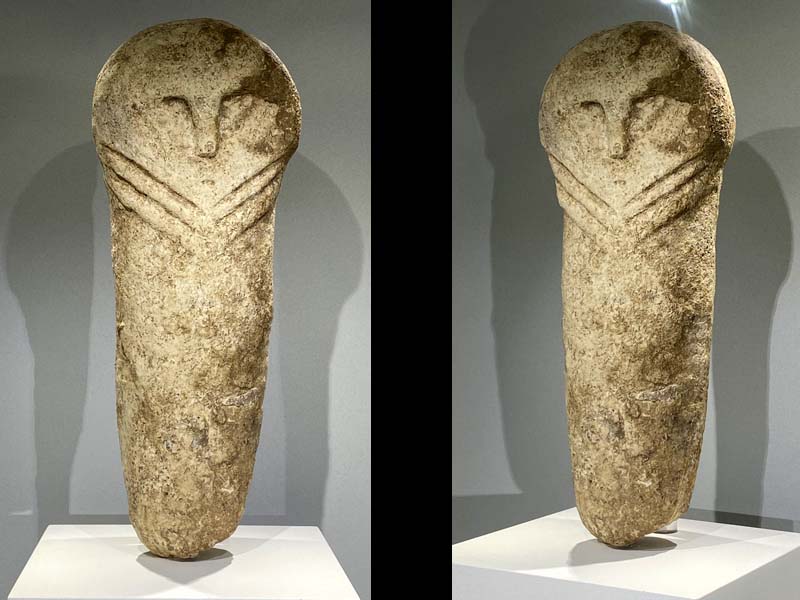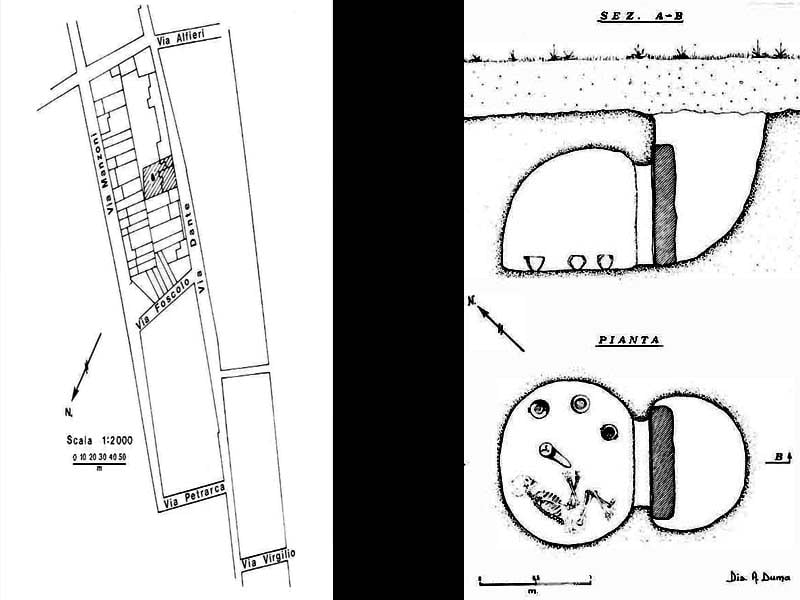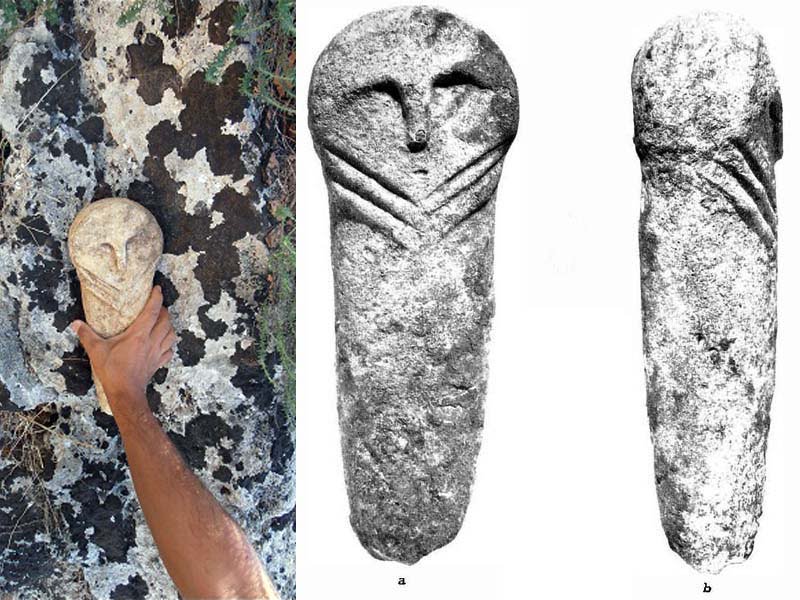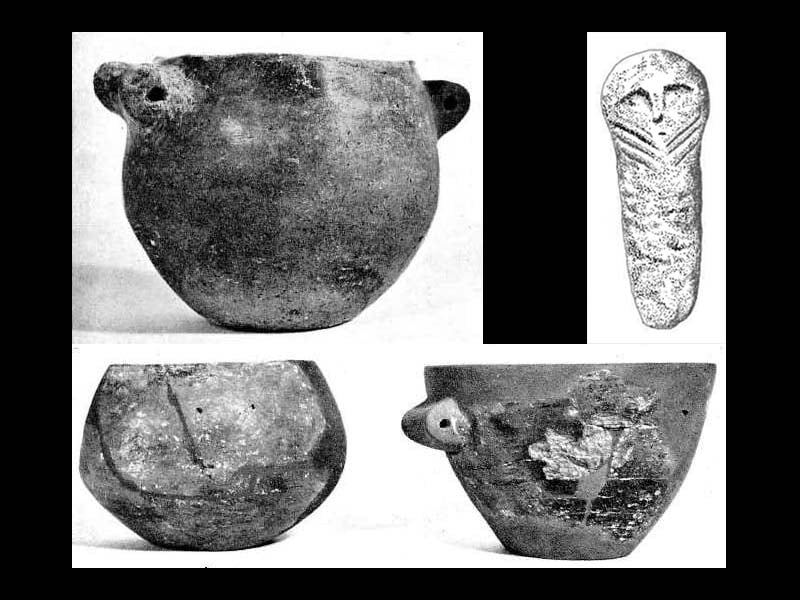The idol of Arnesano is part of the funerary equipment of the burial found in a cave tomb located about 50 centimeters deep from the ground level, equipped with an access shaft of about 1 meter in diameter and a small vaulted chamber ( maximum height 1.10 meters) with an elliptical plan (about 1.50 x 1.20 meters) closed by a vertical limestone slab (about 1,10 x 1.00 meters and 20 cm thick); a drawing by Antonio Duma, collaborator of the Superintendency of the time highlights its characteristics in planimetry and section. The burial lay in a crouched position with the skull facing east, in the direction of the funerary furnishings. The latter consisted of n. 2 ollas and a brownish gray cup attributable to the culture of Diana and the idol in Lecce stone (soft limestone very easy to work) which recalls Aegean specimens. In particular, the anthropomorphic idol in the shape of a "plug", also known as a "T" or an "owl", has remarkable similarities with those found in Cyprus and in the tholos of Aghia Triada in Crete. The methods of emergency recovery of the Arnesano tomb have created numerous doubts on the effective typology of the underground structure, as it could not be specifically created tombs but existing structures used for other purposes, subsequently de-functionalized and then reused for burials ( Anna Maria Tunzi Sisto and Mariangela Lo Zupone, 2010). The idol is schematically represented in the body, of a slightly flattened cylindrical shape so as to offer an elliptical cross-section, tapering downwards without any mention of the lower limbs or arms. The head is instead represented in greater detail, rounded and with the two superciliary arches that connect to the nose by drawing a sort of "T". A short notch marks the mouth and below, three furrows on each side (interpreted as necklaces) join under the chin and mark a triangular profile. Marija Gimbutas, in the Language of the Goddess of her reports: “…At Arnesano, near Lecce, a stone statuette with an owl mask, a chevron immediately below and the lower part of the body reduced to a stub was arranged with respect to the folded skeleton according to the same relationship found in Cuccuru S'Arriu (…the statuette was placed in front of the dead person, who lay in a folded, fetal position…). Near the statue were placed monochrome red vases, beautifully burnished, in the Diana-Bellavista style, typical of southern Italy and Sicily around 4.000 BC…” (M. Gimbutas, 2008).




Historical notes
The idol was found in August 1968, together with other material from the funerary equipment, inside a Neolithic burial which came to light following some excavation work for the opening of a well for the collection of sewage in the courtyard of a private house owned by Mrs. Maria dell'Anna in Barba, located in the Riesci district of the town of Arnesano, in the province of Lecce, exactly in Via Dante n. 38. The local Superintendency was immediately alerted of the find and, having gone to the site, was able to ascertain that the works had partially destroyed the tomb which was, at that point, incorporated in the cockpit.
Already in 1887 Cosimo De Giorgi, a well-known local doctor with a passion for archeology and paleontology, had identified a Neolithic village in the Riesci district, with the discovery of numerous finds, including flint and obsidian tools and various ceramics, material merged into the Sigismondo Provincial Archaeological Museum Castromediano of Lecce. A report by the Superintendent of Antiquities of Apulia of Taranto, Felice Gino Lo Porto, published in the Rivista di Scienze Preistoriche n. XXVII of 1972, reports the following in note no. 3: “Unfortunately and without our knowledge, the bones of this deposition, probably single, were collected in a box and delivered to a certain Argimino, the Arnesano municipal sweeper, who had them placed in the ossuary of the local cemetery. From what has recently been reported to us on the site, the recovery of these finds, although laborious for obvious reasons, does not appear impossible. With the support of the municipal authorities, the enterprise will be attempted in the near future. A photograph taken by the finders of these bones reveals the presence of two femurs and fragments of the tibias, as well as the remains of a skullcap and a lower jaw. A premolar, given to us by the owner of the land, seems to indicate that it is a young adult” (FG Lo Porto, 1972). To date there is no news of the recovery of the bones of the deceased and/or of further investigations, therefore the information is that of the time and above all it has not been possible to ascertain whether the body was male or female.
CARD
LATEST PUBLISHED TEXTS
VISIT THE FACTSHEETS BY OBJECT

